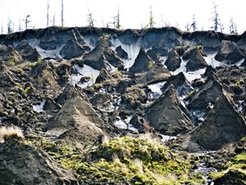No evidence for imminent large methane release

In the current issue of the scientific journal Nature, German scientists explain why a large, imminent release of methane from thawing sub-sea permafrost is a rather unlikely event. The correspondence was motivated by a recent article in the same journal which calculated vast economic costs based on the assumption that such methane release was „likely“.
The original letter, of which Nature published a shortened version in its current issue (i), reads as follows:
“As scientists actively carrying out Arctic-related research, we believe that Whiteman et al. (ii) strongly mis-represent the likelihood of a large and sudden release of methane from the East Siberian Shelf. While they ascribe their statement of a "likely" emission of 50 gigatonnes of methane (CH4) from that region to a paper by Shakhova et al. (iii), the original statement in that paper instead reads "recent knowledge of the problem prevents assessing the probability of such a release in the near or distant future".
Indeed, there are at least three reasons why the scenario that Whiteman et al. present as “likely” is rather unlikely. First, it requires an almost 1000-fold regional increase in CH4 emissions. This is equivalent to a 10-fold increase in global emissions, which is inconsistent with geological evidence: While atmospheric CH4 concentrations raised in response to abrupt warmings during recent deglaciations, isotopic CH4 measurements do not support elevated CH4 hydrate sources (iv).
Second, methane hydrate instability depends on temperatures at the sea floor. There is little evidence that these temperatures have already significantly changed (v) or that a sudden change as required by the regional 1000-fold increase scenario is imminent.
And third, while there have been observations of elevated methane levels in the waters and the overlying atmospheric boundary layer above the East Siberian Shelf (vi), there is no evidence that these are caused by recent warming as compared to natural processes linked to glacial-interglacial changes (vii). In particular, the recent global increase in CH4 growth rate does not seem to be caused by enhanced Arctic methane emissions (viii).
Given these question marks for the input to the economic model used by Whiteman et al., the outcome of their economic model is in our opinion biased towards a single, poorly justifiable scenario. While we welcome studies that aim at quantifying the economic impact of global-warming, we think that a realistic assessment of the uncertainties related to such estimates should always be reported, too.”
(i) Notz et al, Nature 500, 529 (2013) doi:10.1038/500529b
(ii) Whiteman et al., Nature 499, 401-403 (2013)
(iii) Shakhova et al., Doklady Earth Sci. 430, 190–193 (2010).
(iv) Fischer et al., Nature 452, 864-867 (2008)
(v) Nicolsky et al, J. Geophys. Res., 117, F03028 (2012)
(vi) Shakhova et al., Science 327, 1246-1250 (2010)
(vii) Petrenko et al., Science, 329, 1146-1147, (2010)
(viii) Rigby et al., Geophys. Res. Lett., 35, L22805 (2008), Dlugokencky et al., Geophys. Res. Lett., 36, L18803 (2009)












